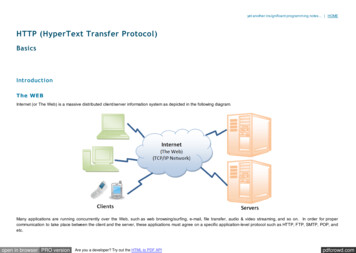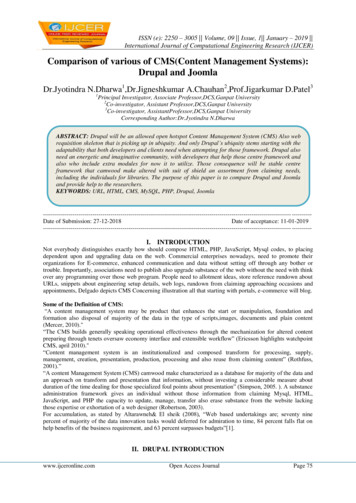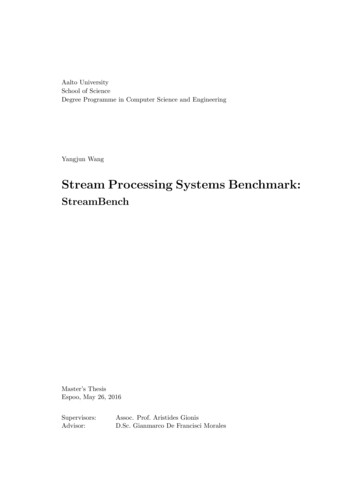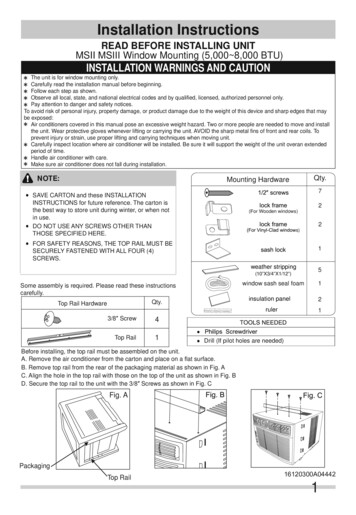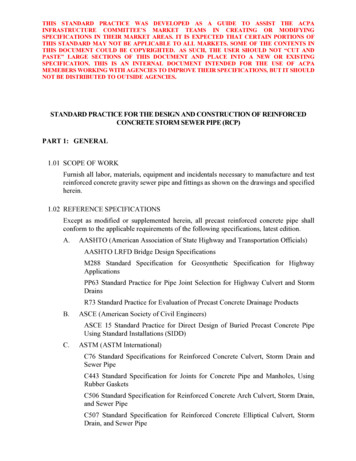
Transcription
Apache Storm
Apache StormAbout the TutorialStorm was originally created by Nathan Marz and team at BackType. BackType is a socialanalytics company. Later, Storm was acquired and open-sourced by Twitter. In a short time,Apache Storm became a standard for distributed real-time processing system that allows you toprocess large amount of data, similar to Hadoop. Apache Storm is written in Java and Clojure.It is continuing to be a leader in real-time analytics.This tutorial will explore the principles of Apache Storm, distributed messaging, installation,creating Storm topologies and deploy them to a Storm cluster, workflow of Trident, real-timeapplications and finally concludes with some useful examples.AudienceThis tutorial has been prepared for professionals aspiring to make a career in Big Data Analyticsusing Apache Storm framework. This tutorial will give you enough understanding on creatingand deploying a Storm cluster in a distributed environment.PrerequisitesBefore proceeding with this tutorial, you must have a good understanding of Core Java and anyof the Linux flavors.Copyright & Disclaimer Copyright 2014 by Tutorials Point (I) Pvt. Ltd.All the content and graphics published in this e-book are the property of Tutorials Point (I) Pvt.Ltd. The user of this e-book is prohibited to reuse, retain, copy, distribute or republish anycontents or a part of contents of this e-book in any manner without written consent of thepublisher.We strive to update the contents of our website and tutorials as timely and as precisely aspossible, however, the contents may contain inaccuracies or errors. Tutorials Point (I) Pvt. Ltd.provides no guarantee regarding the accuracy, timeliness or completeness of our website or itscontents including this tutorial. If you discover any errors on our website or in this tutorial,please notify us at contact@tutorialspoint.comi
Apache StormTable of ContentsAbout the Tutorial.iAudience.iPrerequisites .iCopyright & Disclaimer.iTable of Contents .ii1.APACHE STORM – INTRODUCTION .1What is Apache Storm? .1Apache Storm vs Hadoop .1Use-Cases of Apache Storm .2Apache Storm – Benefits .32.APACHE STORM – CORE CONCEPTS.4Topology .5Tasks .5Workers .6Stream Grouping .63.STORM – CLUSTER ARCHITECTURE .94.APACHE STORM – WORKFLOW .115.STORM – DISTRIBUTED MESSAGING SYSTEM.12What is Distributed Messaging System? .12Thrift Protocol .136.APACHE STORM – INSTALLATION.14Step 1: Verifying Java Installation .14Step 2: ZooKeeper Framework Installation .15Step 3: Apache Storm Framework Installation .17ii
Apache Storm7.APACHE STORM – WORKING EXAMPLE .19Scenario – Mobile Call Log Analyzer .19Spout Creation .19Bolt Creation .23Call log Creator Bolt.24Call log Counter Bolt.26Creating Topology .27Local Cluster.28Building and Running the Application.29Non-JVM languages.308.APACHE STORM – TRIDENT .32Trident Topology .32Trident Tuples .32Trident Spout .32Trident Operations .33State Maintenance .37Distributed RPC .37When to Use Trident?.37Working Example of Trident .37Building and Running the Application.419.APACHE STORM IN TWITTER .43Twitter .43Hashtag Reader Bolt.47Hashtag Counter Bolt .49Submitting a Topology.50Building and Running the Application.51iii
Apache Storm10. APACHE STORM IN YAHOO! FINANCE.53Spout Creation .53Bolt Creation .55Submitting a Topology.57Building and Running the Application.5811. APACHE STORM – APPLICATIONS.59Klout .59The Weather Channel.59Telecom Industry.59iv
1.Apache Storm – IntroductionApache StormWhat is Apache Storm?Apache Storm is a distributed real-time big data-processing system. Storm is designed toprocess vast amount of data in a fault-tolerant and horizontal scalable method. It is astreaming data framework that has the capability of highest ingestion rates. Though Storm isstateless, it manages distributed environment and cluster state via Apache ZooKeeper. It issimple and you can execute all kinds of manipulations on real-time data in parallel.Apache Storm is continuing to be a leader in real-time data analytics. Storm is easy to setup,operate and it guarantees that every message will be processed through the topology at leastonce.Apache Storm vs HadoopBasically Hadoop and Storm frameworks are used for analyzing big data. Both of themcomplement each other and differ in some aspects. Apache Storm does all the operationsexcept persistency, while Hadoop is good at everything but lags in real-time computation.The following table compares the attributes of Storm and Hadoop.StormHadoopReal-time stream processingBatch processingStatelessStatefulMaster/Slave architecture with ZooKeeperbased coordination. The master node iscalled as nimbus and slaves aresupervisors.Master-slave architecture with/withoutZooKeeper based coordination. Master nodeis job tracker and slave node is tasktracker.A Storm streaming process can access tensof thousands messages per second oncluster.Storm topology runs until shutdown by theuser or an unexpected unrecoverable failure.Hadoop Distributed File System (HDFS) usesMapReduce framework to process vastamount of data that takes minutes or hours.MapReduce jobs are executed in a sequentialorder and completed eventually.Both are distributed and fault-tolerant5
Apache StormIf nimbus / supervisor dies, restarting makesit continue from where it stopped, hencenothing gets affected.If the JobTracker dies, all the running jobs arelost.Use-Cases of Apache StormApache Storm is very famous for real-time big data stream processing. For this reason, mostof the companies are using Storm as an integral part of their system. Some notable examplesare as follows:Twitter – Twitter is using Apache Storm for its range of “Publisher Analytics products”.“Publisher Analytics Products” process each and every tweets and clicks in the TwitterPlatform. Apache Storm is deeply integrated with Twitter infrastructure.NaviSite – NaviSite is using Storm for Event log monitoring/auditing system. Every logsgenerated in the system will go through the Storm. Storm will check the message against theconfigured set of regular expression and if there is a match, then that particular message willbe saved to the database.Wego – Wego is a travel metasearch engine located in Singapore. Travel related data comesfrom many sources all over the world with different timing. Storm helps Wego to search realtime data, resolves concurrency issues and find the best match for the end-user.Apache Storm – BenefitsHere is a list of the benefits that Apache Storm offers: Storm is open source, robust, and user friendly. It could be utilized in small companiesas well as large corporations. Storm is fault tolerant, flexible, reliable, and supports any programming language. Allows real-time stream processing. Storm is unbelievably fast because it has enormous power of processing the data. Storm can keep up the performance even under increasing load by adding resourceslinearly. It is highly scalable. Storm performs data refresh and end-to-end delivery response in seconds or minutesdepends upon the problem. It has very low latency. Storm has operational intelligence.6
Apache Storm Storm provides guaranteed data processing even if any of the connected nodes in thecluster die or messages are lost.7
2.Apache Storm – Core ConceptsApache StormApache Storm reads raw stream of real-time data from one end and passes it through asequence of small processing units and output the processed / useful information at the otherend.The following diagram depicts the core concept of Apache Storm.Let us now have a closer look at the components of Apache Storm:ComponentsDescriptionTupleTuple is the main data structure in Storm. It is a list of ordered elements.By default, a Tuple supports all data types. Generally, it is modelled as aset of comma separated values and passed to a Storm cluster.StreamStream is an unordered sequence of tuples.SpoutsSource of stream. Generally, Storm accepts input data from raw datasources like Twitter Streaming API, Apache Kafka queue, Kestrel queue,etc. Otherwise you can write spouts to read data from datasources.“ISpout" is the core interface for implementing spouts. Some of thespecific interfaces are IRichSpout, BaseRichSpout, KafkaSpout, etc.8
Apache StormBoltsBolts are logical processing units. Spouts pass data to bolts and boltsprocess and produce a new output stream. Bolts can perform theoperations of filtering, aggregation, joining, interacting with data sourcesand databases. Bolt receives data and emits to one or more bolts. “IBolt”is the core interface for implementing bolts. Some of the commoninterfaces are IRichBolt, IBasicBolt, etc.Let’s take a real-time example of “Twitter Analysis” and see how it can be modelled in ApacheStorm. The following diagram depicts the structure.The input for the “Twitter Analysis” comes from Twitter Streaming API. Spout will read thetweets of the users using Twitter Streaming API and output as a stream of tuples. A singletuple from the spout will have a twitter username and a single tweet as comma separatedvalues. Then, this steam of tuples will be forwarded to the Bolt and the Bolt will split the tweetinto individual word, calculate the word count, and persist the information to a configureddatasource. Now, we can easily get the result by querying the datasource.9
Apache StormTopologySpouts and bolts are connected together and they form a topology. Real-time application logicis specified inside Storm topology. In simple words, a topology is a directed graph wherevertices are computation and edges are stream of data.A simple topology starts with spouts. Spout emits the data to one or more bolts. Boltrepresents a node in the topology having the smallest processing logic and the output of abolt can be emitted into another bolt as input.Storm keeps the topology always running, until you kill the topology. Apache Storm’s mainjob is to run the topology and will run any number of topology at a given time.TasksNow you have a basic idea on spouts and bolts. They are the smallest logical unit of thetopology and a topology is built using a single spout and an array of bolts. They should beexecuted properly in a particular order for the topology to run successfully. The execution ofeach and every spout and bolt by Storm is called as “Tasks”. In simple words, a task is eitherthe execution of a spout or a bolt. At a given time, each spout and bolt can have multipleinstances running in multiple separate threads.WorkersA topology runs in a distributed manner, on multiple worker nodes. Storm spreads the tasksevenly on all the worker nodes. The worker node’s role is to listen for jobs and start or stopthe processes whenever a new job arrives.Stream GroupingStream of data flows from spouts to bolts or from one bolt to another bolt. Stream groupingcontrols how the tuples are routed in the topology and helps us to understand the tuples flowin the topology. There are four in-built groupings as explained below.Shuffle Grouping10
Apache StormIn shuffle grouping, an equal number of tuples is distributed randomly across all of theworkers executing the bolts. The following diagram depicts the structure.11
Apache StormField GroupingThe fields with same values in tuples are grouped together and the remaining tuples keptoutside. Then, the tuples with the same field values are sent forward to the same workerexecuting the bolts. For example, if the stream is grouped by the field “word”, then the tupleswith the same string, “Hello” will move to the same worker. The following diagram shows howField Grouping works.Global GroupingAll the streams can be grouped and forward to one bolt. This grouping sends tuples generatedby all instances of the source to a single target instance (specifically, pick the worker withlowest ID).12
Apache StormAll GroupingAll Grouping sends a single copy of each tuple to all instances of the receiving bolt. This kindof grouping is used to send signals to bolts. All grouping is useful for join operations.13
Apache Storm14
3.Storm – Cluster ArchitectureApache StormOne of the main highlight of the Apache Storm is that it is a fault-tolerant, fast with no “SinglePoint of Failure” (SPOF) distributed application. We can install Apache Storm in as manysystems as needed to increase the capacity of the application.Let’s have a look at how the Apache Storm cluster is designed and its internal architecture.The following diagram depicts the cluster design.Apache Storm has two type of nodes, Nimbus (master node) and Supervisor (worker node).Nimbus is the central component of Apache Storm. The main job of Nimbus is to run theStorm topology. Nimbus analyzes the topology and gathers the task to be executed. Then, itwill distributes the task to an available supervisor.A supervisor will have one or more worker process. Supervisor will delegate the tasks toworker processes. Worker process will spawn as many executors as needed and run the task.Apache Storm uses an internal distributed messaging system for the communication betweennimbus and supervisors.ComponentsDescription15
Apache StormNimbusNimbus is a master node of Storm cluster. All other nodes in thecluster are called as worker nodes. Master node is responsible fordistributing data among all the worker nodes, assign tasks to workernodes and monitoring failures.SupervisorThe nodes that follow instructions given by the nimbus are called asSupervisors. A supervisor has multiple worker processes and itgoverns worker processes to complete the tasks assigned by thenimbus.Worker processA worker process will execute tasks related to a specific topology. Aworker process will not run a task by itself, instead it createsexecutors and asks them to perform a particular task. A workerprocess will have multiple executors.ExecutorAn executor is nothing but a single thread spawn by a workerprocess. An executor runs one or more tasks but only for a specificspout or bolt.TaskA task performs actual data processing. So, it is either a spout or abolt.ZooKeeper frameworkApache ZooKeeper is a service used by a cluster (group of nodes)to coordinate between themselves and maintaining shared data withrobust synchronization techniques. Nimbus is stateless, so itdepends on ZooKeeper to monitor the working node status.ZooKeeper helps the supervisor to interact with the nimbus. It isresponsible to maintain the state of nimbus and supervisor.Storm is stateless in nature. Even though stateless nature has its own disadvantages, itactually helps Storm to process real-time data in the best possible and quickest way.Storm is not entirely stateless though. It stores its state in Apache ZooKeeper. Since the stateis available in Apache ZooKeeper, a failed nimbus can be restarted and made to work fromwhere it left. Usually, service monitoring tools like monit will monitor Nimbus and restart itif there is any failure.Apache Storm also have an advanced topology called Trident Topology with statemaintenance and it also provides a high-level API like Pig. We will discuss all these featuresin the coming chapters.16
4.Apache Storm – WorkflowApache StormA working Storm cluster should have one nimbus and one or more supervisors. Anotherimportant node is Apache ZooKeeper, which will be used for the coordination between thenimbus and the supervisors.Let us now take a close look at the workflow of Apache Storm: Initially, the nimbus will wait for the “Storm Topology” to be submitted to it. The Once a topology is submitted, it will process the topology and gather all the tasks thatare to be carried out and the order in which the task is to be executed. Then, the nimbus will evenly distribute the tasks to all the available supervisors. At a particular time interval, all supervisors will send heartbeats to the nimbus toinform that they are still alive. When a supervisor dies and doesn’t send a heartbeat to the nimbus, then the nimbusassigns the tasks to another supervisor. When the nimbus itself dies, supervisors will work on the already assigned task withoutany issue. Once all the tasks are completed, the supervisor will wait for a new task to come in. In the meantime, the dead nimbus will be restarted automatically by servicemonitoring tools. The restarted nimbus will continue from where it stopped. Similarly, the deadsupervisor can also be restarted automatically. Since both the nimbus and thesupervisor can be restarted automatically and both will continue as before, Storm isguaranteed to process all the task at least once. Once all the topologies are processed, the nimbus waits for a new topology to arriveand similarly the supervisor waits for new tasks.By default, there are two modes in a Storm cluster: Local mode: This mode is used for development, testing, and debugging because itis the easiest way to see all the topology components working together. In this mode,we can adjust parameters that enable us to see how our topology runs in differentStorm configuration environments. In Local mode, storm topologies run on the localmachine in a single JVM. Production mode: In this mode, we submit our topology to the working stormcluster, which is composed of many processes, usually running on different machines.17
Apache StormAs discussed in the workflow of storm, a working cluster will run indefinitely until it isshutdown.18
Apache StormEnd of ebook previewIf you liked what you saw Buy it from our store @ https://store.tutorialspoint.com19
Apache Storm 6 Use-Cases of Apache Storm Apache Storm is very famous for real-time big data stream processing. For this reason, most of the companies are using Storm as an integral part of their system. Some notable examples are as follows: Twitter - Twitter is using Apache Storm for its range of "Publisher Analytics products".
